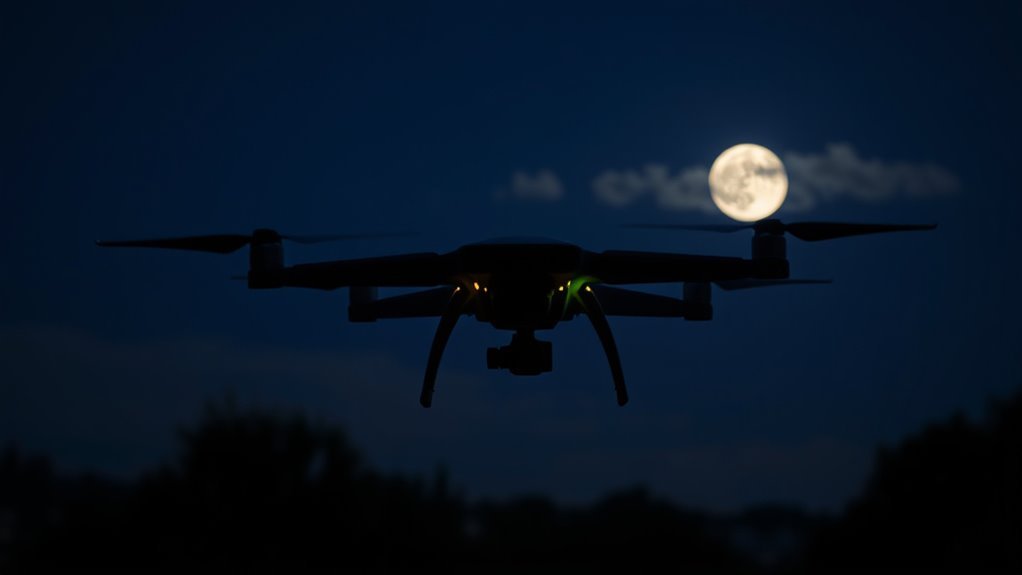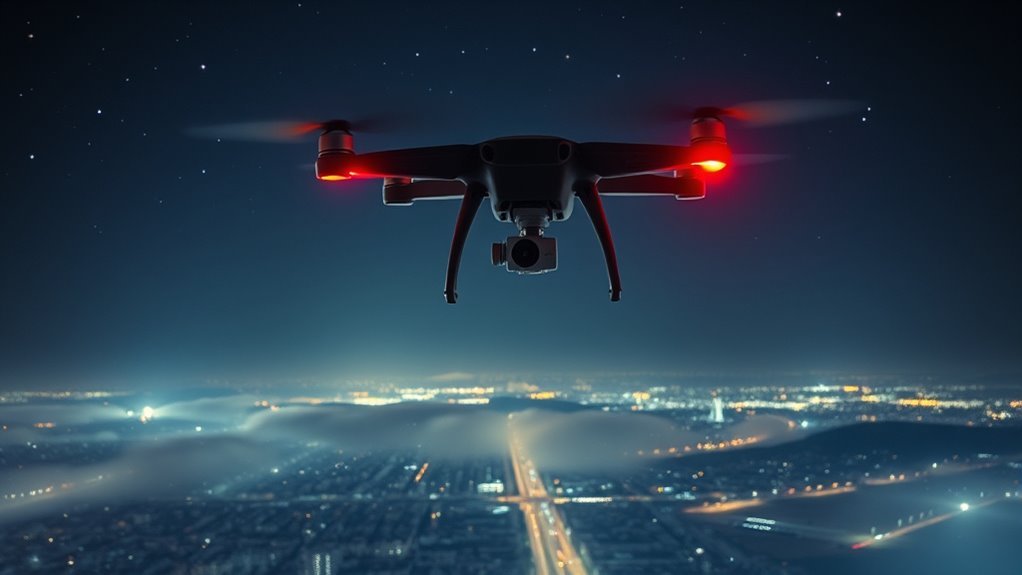Drones fly at night for surveillance primarily due to their advanced sensor capabilities, like thermal imaging, which allows effective monitoring in complete darkness. These sensors enhance visibility and improve threat detection without being visually detected. The use of drones also minimizes risks to personnel and provides real-time data for informed decision-making in security and law enforcement operations. If you’re interested in understanding the broader implications and applications of this technology, there’s more to explore.
Enhanced Visibility With Advanced Sensors

When it comes to nighttime surveillance, advanced sensors are pivotal for enhancing visibility. Utilizing cutting-edge night vision technology, these sensors greatly improve your ability to monitor areas obscured by darkness. The integration of sensor technology allows for real-time data processing, which means you can detect movement and identify objects even in low-light conditions. This capability not only increases situational awareness but also empowers you to act decisively when necessary. With the evolution of lightweight drones equipped with these sensors, surveillance operations become more efficient, providing you with the freedom to operate without traditional limitations. The enhanced visibility offered by night vision systems guarantees that you remain vigilant, safeguarding your interests while maneuvering the complexities of nighttime environments. Moreover, drones like the Draganfly Commander excel in incorporating advanced optical and infrared options for improved precision during nighttime missions.
The Role of Thermal Imaging in Night Operations

Thermal imaging considerably enhances visibility capabilities during night operations, allowing you to identify heat signatures that are otherwise obscured by darkness. This technology improves target detection efficiency, enabling quicker response times and better situational awareness. As you employ drones equipped with thermal sensors, the advantages become evident in various surveillance applications. Moreover, these cameras excel in detecting infrared radiation with clarity in low-light scenarios, further augmenting operational effectiveness. Additionally, the integration of advanced obstacle avoidance systems ensures safer navigation during night flights, enhancing overall operational reliability.
Enhanced Visibility Capabilities
While traditional optical cameras struggle in low-light conditions, enhanced visibility capabilities through thermal imaging have revolutionized night surveillance operations. These systems utilize infrared technology to detect heat signatures, allowing you to navigate effectively during nighttime missions. Unlike standard cameras, thermal imaging excels in low light performance, providing clear imagery regardless of ambient light. This enables you to monitor environments and detect potential threats with precision, all while maintaining operational stealth. The ability to see through darkness enhances your situational awareness, making nighttime navigation safer and more efficient. As a result, drones equipped with thermal imaging become indispensable tools for surveillance, offering you the freedom to conduct operations without the limitations imposed by conventional visual technologies.
Target Detection Efficiency
As the complexity of nighttime operations increases, achieving high target detection efficiency becomes crucial. Utilizing thermal imaging technology enhances target acquisition capabilities considerably. Unlike visible light, thermal imaging detects heat signatures, allowing you to identify and track targets in complete darkness. This advantage is essential for surveillance missions, where conventional sensors may fail. By employing drones equipped with advanced thermal sensors, you can effectively monitor vast areas, ensuring no target goes unnoticed. The precision of these systems minimizes false positives, streamlining your operational response. Furthermore, the ability to assess threats in real-time supports tactical decision-making, granting you the freedom to act swiftly and decisively. Ultimately, thermal imaging is a game-changer in optimizing target detection during night operations.
Increased Discreetness for Surveillance Tasks

Drones equipped for nighttime surveillance enhance discreetness considerably, allowing operators to conduct monitoring tasks without drawing attention. By utilizing advanced stealth technology, these drones minimize noise and visual detection, making them ideal for covert nighttime operations. Their ability to fly under the radar, both literally and figuratively, means you can gather essential intelligence without alarming subjects. The combination of thermal imaging and low-light cameras further complements this stealth approach, enabling effective monitoring in complete darkness. This heightened level of discreetness not only protects the integrity of the surveillance mission but also supports the fundamental principles of privacy and freedom, empowering citizens to maintain a secure environment while resisting undue scrutiny. Additionally, advancements in AI-enhanced flight capabilities ensure that these drones navigate complex environments with ease, further enhancing their effectiveness during nighttime missions. Furthermore, the integration of thermal imaging allows for swift detection of heat signatures, making it easier to identify individuals and potential threats in low-light conditions.
Applications in Security and Law Enforcement
Drones equipped with advanced imaging technology greatly enhance visibility in darkness, allowing for precise monitoring of areas that would otherwise remain unobservable. This capability improves incident response efficiency by enabling law enforcement to assess situations rapidly and accurately. Additionally, the use of drones facilitates covert surveillance operations, minimizing the risk of detection while gathering critical intelligence. The ability to provide real-time communication further empowers teams to make informed decisions during high-stakes situations. Furthermore, AI-powered analytics in drones can aid in threat detection, significantly improving the effectiveness of surveillance missions.
Enhanced Visibility in Darkness
While traditional surveillance methods often struggle in low-light conditions, advanced drone technology has emerged as a game changer for security and law enforcement applications. Drones equipped with infrared cameras and thermal imaging capabilities enhance visibility in darkness, overcoming visual limitations that ground-based units face. This allows you to conduct effective nighttime navigation, ensuring thorough monitoring of critical areas without compromising safety. With the ability to cover vast areas quickly, these drones provide real-time data, empowering law enforcement to respond proactively to potential threats. As a result, you gain a tactical advantage, fostering a safer environment while upholding individual freedoms. Utilizing drones for night operations represents a significant leap forward in surveillance technology, enhancing overall situational awareness and operational effectiveness.
Incident Response Efficiency
As law enforcement agencies increasingly adopt drone technology, incident response efficiency has improved dramatically. Drones enhance incident assessment by providing real-time aerial perspectives, enabling quick identification of threats and situational dynamics. Their ability to cover large areas swiftly allows responders to gather vital information without jeopardizing safety. Furthermore, drones facilitate response coordination by linking multiple units on the ground, ensuring that intelligence is shared in real-time. This integration streamlines decision-making processes, allowing for a more effective deployment of resources. By minimizing response times and enhancing situational awareness, drones empower law enforcement to act decisively, ultimately fostering a safer environment. Embracing this technology not only enhances operational capabilities but also upholds the values of transparency and accountability within the community.
Covert Surveillance Operations
The enhanced situational awareness provided by drones is not only beneficial for incident response but also highly effective for covert surveillance operations in security and law enforcement. By employing advanced stealth techniques, drones can operate undetected, gathering critical intelligence without alerting suspects. Their ability to fly at night enhances this capability, allowing for unobtrusive monitoring in low-light conditions. You can utilize drones to conduct covert operations in sensitive environments, minimizing risks to personnel while maximizing data collection. With high-resolution cameras and thermal imaging, drones capture detailed footage, aiding in threat assessment and criminal investigations. This strategic approach not only improves operational efficiency but also respects civil liberties by ensuring that surveillance is discreet and targeted.
Search and Rescue Missions Under the Cover of Darkness
When darkness envelops a search area, drones equipped with advanced thermal imaging and night vision capabilities become invaluable tools for rescue teams. They enable effective nighttime navigation and enhance rescue coordination, ensuring that critical operations can proceed safely and efficiently.
Key advantages of using drones for search and rescue at night include:
- Enhanced Visibility: Thermal imaging detects heat signatures, allowing for quick identification of individuals in distress. This technology is similar to the advanced sensors found in drones like the Amazon MK30 which enhance reliability.
- Wider Coverage: Drones can cover extensive areas rapidly, increasing the chances of locating missing persons.
- Real-Time Data: Live feeds provide instant updates to rescue coordinators, facilitating informed decision-making.
- Reduced Risk: Utilizing drones minimizes the need for ground personnel in hazardous conditions, enhancing overall safety.
Moreover, the integration of advanced surveillance capabilities allows for precise monitoring of environments, improving the effectiveness of search operations.
Incorporating drones into nighttime operations markedly improves outcomes in search and rescue missions.
Challenges and Considerations for Nighttime Drone Flights
Although nighttime drone flights offer significant advantages for surveillance and search operations, they also present unique challenges that operators must navigate. One of the primary concerns is adherence to nighttime regulations, which can vary by jurisdiction and may restrict flight times or require additional permits. You’ll need to guarantee compliance to avoid legal repercussions. Additionally, battery limitations become more pronounced in low-light conditions; colder temperatures can reduce battery efficiency, potentially shortening flight durations. This necessitates meticulous planning regarding mission length and power management. Furthermore, maintaining situational awareness in darkness requires advanced sensors and skilled piloting, increasing operational complexity. Understanding material composition is also vital for strategizing flight paths and optimizing sensor usage during nighttime operations. Operators must also remain cautious of local drone regulations to ensure that they are flying within permissible limits at all times.
Frequently Asked Questions
Are Nighttime Drone Flights Legal in All Areas?
Maneuvering nighttime skies isn’t always a free-for-all; you’ve gotta check local nighttime regulations. While some areas allow night flights, legal restrictions might ground you. Always guarantee you’re flying within the law to avoid trouble.
How Do Drones Navigate in Complete Darkness?
Drones navigate in complete darkness using night vision technology and infrared sensors. These systems enhance visibility, allowing you to capture clear images and data, even when light’s absent, ensuring effective operation during nighttime missions.
What Types of Drones Are Best for Night Surveillance?
You might think any drone could suffice for night surveillance, but models equipped with thermal imaging and infrared sensors excel. They detect heat signatures, ensuring effective monitoring in darkness, granting you unparalleled situational awareness and freedom.
Do Night Operations Require Special Pilot Certifications?
Yes, night operations typically require special pilot training. You’ll need to be proficient in night vision techniques and understand the unique challenges nighttime flying presents to guarantee safety and compliance with regulations.
What Are the Costs Associated With Nighttime Drone Flights?
Nighttime drone flights involve increased operational expenses due to specialized night vision equipment, enhanced maintenance, and potential regulatory fees. You’ll need to factor in these costs when planning for efficient and effective nighttime surveillance missions.

